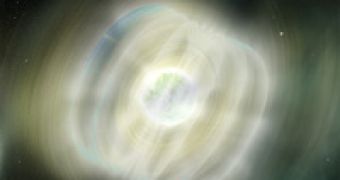A magnetar is a neutron star with an extremely powerful magnetic field, the decay of which powers the emission of copious amounts of high-energy electromagnetic radiation, particularly X-rays and gamma-rays.
Astronomers using data from several X-ray satellites have caught a recently discovered magnetar in a sort of giant cosmic hiccup that still has them puzzled.
In multiple reports in the Astrophysical Journal and Monthly Notices of the Royal Astronomical Society, the researchers describe the behavior of this body, located in a star cluster about 15 000 light-years away in the Ara constellation in the southern hemisphere. The magnetar goes by the unwieldy official name CXOU J164710.2-455216, or more informally, the "Westerlund 1 magnetar."
It produced a beam of X-ray light that, like the beam from a lighthouse, swept across Earth once every ten seconds. This allowed its rotational rate to be determined very precisely.
The event that produced the burst also caused the magnetar to shine 100 times more brightly, created three separate beams that sweep past Earth where previously only one had existed, and sped up its rotation rate by about a thousandth of a second.
In just five days, the object produced a burst that luckily came at a time when it was being heavily observed with several satellites, including the European Space Agency's X-ray satellite, XMM-Newton, and NASA's Swift X-ray and gamma-ray observatory.
"We only know of about a dozen magnetars," says Michael Muno, a scientist at the California Institute of Technology's Space Radiation Laboratory, and the original discoverer of the magnetar in 2005. "In brief, what we observed was a seismic event on the magnetar, which tells us a lot about the stresses these objects endure."
There are some possible explanations, like the fact that the magnetic fields inside the neutron star are probably wound up, like a twisted spring, like plate tectonics here on Earth, and as the magnetic fields unwind, they put stress on the outer crust.
The crust would resist these stresses for a while, but would eventually fracture, producing a seismic event. The fractures would cause the magnetar's surface to shine brightly from multiple sources.
Scientists are now thinking that the possible finding of these magnetars, will force them to re-evaluate their understanding of what happens when stars die.

 14 DAY TRIAL //
14 DAY TRIAL //